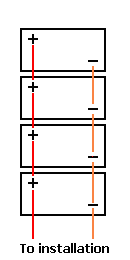I am using a 4 pack of 35 Amp 12 volt AGM Interstate DCM-0035 AGM batteries as a "transportable" power bank. These are wired in Parallel to provide 140 amps (theorhetical) of 12 volt power.
The DCM-0035 battery ia advertised as a "VALVE-REGULATED LEAD-ACID BATTERY FOR DEEP-CYCLE APPLICATIONS". They weigh 23.1 pounds each and come with a top carry strap. This makes them transportable by hand (67 years old = two trips).
I have a very detailed chart of Constant Current Discharge Ratings supplied with the battery.
By the chart it shows that a single DCM-0035 can supply 3.6 amps for 8 hours with an end point of 10.8 volts. For planning could I project that 4 DCM-0035 batteries in parallel could supply 3.6 amps for 32 hours and end at the same 10.8 volts. (4 x the 8 hours).
I guess I am asking if each battery would "contribute" equally to supply the total amp output (3.6 amps/4). If so, then I can use the Constant Current Discharge Ratings chart supplied.
Thanks in advance for any guidance and/or advice.
rch
The DCM-0035 battery ia advertised as a "VALVE-REGULATED LEAD-ACID BATTERY FOR DEEP-CYCLE APPLICATIONS". They weigh 23.1 pounds each and come with a top carry strap. This makes them transportable by hand (67 years old = two trips).
I have a very detailed chart of Constant Current Discharge Ratings supplied with the battery.
By the chart it shows that a single DCM-0035 can supply 3.6 amps for 8 hours with an end point of 10.8 volts. For planning could I project that 4 DCM-0035 batteries in parallel could supply 3.6 amps for 32 hours and end at the same 10.8 volts. (4 x the 8 hours).
I guess I am asking if each battery would "contribute" equally to supply the total amp output (3.6 amps/4). If so, then I can use the Constant Current Discharge Ratings chart supplied.
Thanks in advance for any guidance and/or advice.
rch

Comment